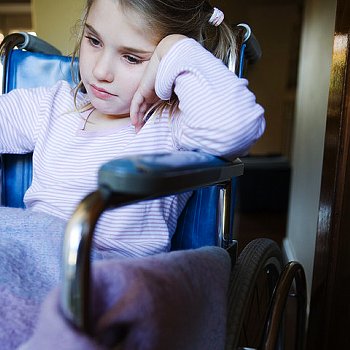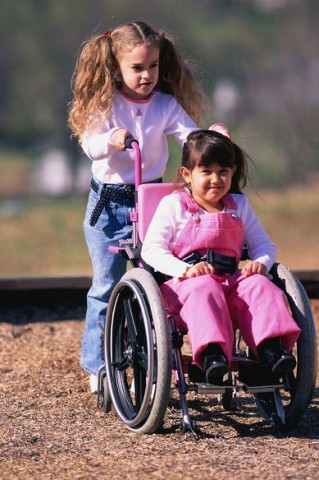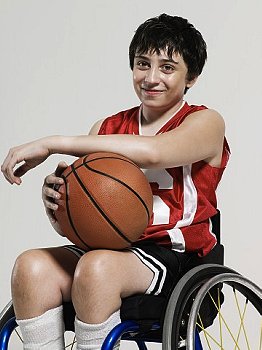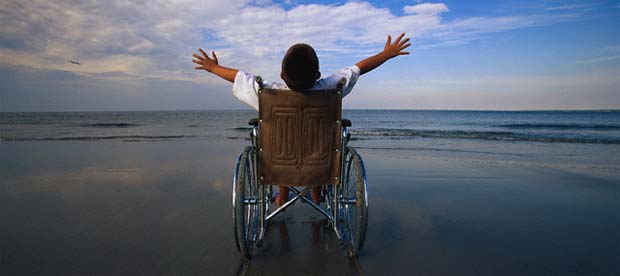Pediatric Spinal Cord Injury
Spinal cord injuries, particularly in children, can present parents and caregivers with complicated and countless challenges. Just as adults are continually one degree of separation away from paralysis and spinal cord injury, so too are children. Depending on the source of the data, the incidence of pediatric spinal cord injury (ages 0 to 20) reportedly accounts for almost 20% of all new spinal cord injuries each year. The 0 to 15 year age group accounts for 2%-5%, while the 16 to 20 age group accounts for 14%-18% of these new injuries. More male children incur SCI than female children.
Pediatric Spinal Cord Injury Physics

In both child and adult, there are three unique mechanisms which create a spinal cord injury: longitudinal compression, hinging, and shearing. Each mechanism causes unique spinal and neural injuries which call for specific acute treatment and long term care management.
A longitudinal compression occurs when one vertebra is crushed lengthwise against another; one such accident which can cause this type of injury can occur as the result of a fall from a height. The mechanism of hinging occurs if the spinal column experiences extreme bending such as whiplash. The movements experienced during whiplash often cause additional fractures in children.
The predominant causes of injuries are pedestrian ( vs. vehicular) accidents and falls, accounting for over 75% of all pediatric spinal cord injuries. Shearing of the spinal column occurs when, for example, a pedestrian is struck by an automobile. The shearing mechanism is a combination of hinging and a rotational movement causing a jerking, twisting and stretching motion of the spine.
Depending on the strength of force and the age of individual, the severity of the injury and the corresponding extent of medical intervention is related to whether vertebra was dislocated or fractures, ligaments and connective tissue was bruised, ruptured or severed, and if these tissues sustained bruising. Additionally, subsequent blood clots or even shock to the surrounding spinal region can contribute to the level of injury.
Etiology Of Pediatric Spinal Cord Injury
Due to a larger head size relative to a smaller proportioned body, children tend to be heavier on top. Vigorous, abusive shaking by an adult can quickly damage a small, immature spine of a top-heavy child. The instability and flexibility of the young child’s neural/spine structure can contribute to the level of injury. The spinal cord in the youngest of children can stretch up to 2 inches (5.08 cm), whereas in older children and adults the spinal cord may stretch only a ¼ inch (0.64 cm). The greater flexibility allows for more stretching and increases the potential damage to the young spinal cord with little or no obvious damage to the surrounding bony outer structures.

At 40% moving vehicle accidents continue to be the primary cause of SCI in children; in two-thirds of these accidents the children were not protected by any restraints. Ill-fitting car seats or improperly adjusted seat belts can also generate a spinal injury. Bruising and additional intra-abdominal trauma are the traditional markers of inappropriate seat belt or car seat use, commonly referred to seatbelt syndrome.
Although statistically rare, infants can sustain spinal injury as the result of a birthing accident and often result in a poor outcome. During a protracted and difficult birthing process, the injury will typically affect the spinal cord in the neck area. Standard presentation of the fetus just prior to birth is a “normal occipital” position, in that the top of the head is firmly pressed against the bottom of the womb.
There are times when the fetus assumes a “breech position”. Although “breech” describes a number of fetal positions including buttocks, crossed legs, or feet directly above the birth canal, a particularly risky position for the fetus is having the brow or face pressed against the bottom of the womb. While in the birth canal, the fetus’ spine or neck can become extended, bent or compressed, particularly if labor becomes lengthy and difficult. Mechanical repositioning and use of forceps for infant extraction also contribute to the possibility of birth injury.
Anatomic and behavioral differences between adults and children account for the variation in injury type and severity. Almost 75% of SCI in children occurs in the C1-7 neck region, the younger the child the higher the cervical injury. As children approach 8–10 yrs of age, the spine has grown to almost adult size, therefore injures more closely mirrors adult SCI and treatment. As children begin to approach the age of eight, pediatric SCI begins to resemble adult SCI, with less injuries at the C1-2 level and more injuries at the C5-6.
While birth accidents, vigorous shaking, and improper use of vehicle restraints are unique to the population of youngsters, the remainders of injury causes are similar to that of the adult population. These spinal injuries can also be attributed to falls, sports injuries, diving accidents, trampoline accidents, and violent assault.
Pediatric Spine Stabilization
Acute treatment of a child diagnosed with SCI depends on age of child and the level of injury. Of primary concern to medical staff is stabilization, preventing vertebra from moving and shifting and risking further damage to spine.
Treatment is highly individualized, dependant on the child’s age, severity of spinal damage, and other injuries the child may have incurred. The child’s rate of growth, smaller bones, some of which have not fused yet, can create surgical dilemmas. There are two standard methods for spinal stabilization for consideration: the first method, “decompression”, takes pressure off the spine; the second uses wires, screws, metal plates, or rods to surgically stabilize the spine. “Internal fixation or instrumentation” protects the tissues of spinal cord while providing bone strength.
Careful consideration is given in deciding if surgery is required and if so, when it should be performed, as surgery can have adverse implications on a child’s growth and development. Additionally, risks from surgery are higher for young children. Timing of surgery risks: children who have not completed growth at time of injury (remember the spine is almost adult size between 8-10 yrs) may encounter problems later.
While stabilizing the vertebrae is of primary importance, a consequence of such surgery is curvature of the spine if the child’s spine is fixated while child is still growing. A growth spurt can trigger scoliosis if surgery is done before the end of major growth spurt. Curvature of the spine as a consequence of spinal cord injury is observed more in girls than boys. This curvature can also cause hip dislocation. Treatment for spine deformity is bracing, or more surgery if curvature is severe and bracing doesn’t work.
The use of methylprednisolone is becoming a protocol administration in trauma units and children’s hospitals for SCI. This medication, widely marketed as Solu-Medrol, has been found to provide multiple levels of favorable outcomes in some children and adults experiencing SCI.
Pediatric Wheelchair Choices

Not so long ago, if a child experiencing SCI was in need of a wheelchair, very little thought was given to the size of the child and an appropriately sized chair. Prescribing a chair suitably matched to the child’s level of paralysis, physical capabilities, and interests simply was not a part of the rehab agenda. More often than not, the child was given an adult size chair for the child “to grow into”. Now, as with adult chairs, there are far more options available to choose from.
Although the circumstances of a child’s physical needs are of primary importance, their personal preferences are an important factor. A wheelchair is not just a form of transport; it represents an extension of the child’s personality. It should suit their physical needs as well as their sense of adventure and need for inclusion. There is more to the choice than power or manual as far as the child is concerned. Involving the child in the decision making process when choosing a wheelchair or other mobility device is important. As they grow older, they are more adequately able to describe their needs and desires.
Just as a child enjoys picking out their own shoes and reading glasses, so too is it beneficial for the child to participate in the selection of their mobility devices. Manufacturers are also responding to the needs of children in having chairs that fit more easily into their environment and social situations. This may be accomplished with a more streamlined appearance and/or a wider selection of upholstery and/or frame colors.
Because their bodies are rapidly growing and changing, choosing chairs for children and adolescents requires consideration of factors which are not a part of the adult wheelchair selection process. One of these is the frequency with which a chair must be changed or replaced: the high cost of replacing a chair, and because insurance providers often place limitations on the frequency of chair replacement, purchasing a new chair each year can be financially prohibitive, if not impossible. Some government bodies, associations and charities offer financial assistance to part fund the exorbitant cost of wheelchairs but typically they only cover a small range of basic chairs.
Growth chairs or chairs with growth kits offer an alternative by allowing adjustments to be made in the existing chair to accommodate a growing child. This may include utilizing replaceable components or designing the chair with features that can be converted from a smaller size to a larger size. Considering how fast children grow, particularly during adolescence since puberty can include sudden and explosive growth, investing in a growth chair could save money over the long term.

Conclusion
This article only briefly examines just a few of the many issues encountered by children who have been diagnosed with a spinal cord injury. A young child nestled in smaller size wheelchair or other means of mobility may cause some people to react in a negative manner invoking exclusion. Many tend to pity a disabled child instead of celebrating their abilities and their childhood. Some fail to see the lively and happy child, focusing instead on what they may or may not be able to do.
Children are amazingly resilient and strong. In an accepting understanding supportive environment even the youngest child can and will learn how to adapt to life with a spinal cord injury. Making age-appropriate adjustments for children during the early stages of injury and recovery can greatly increase the chances of positive outcomes for the child.
Resources
- American Association of Neurological Surgeons; http://www.aans.org
- Children’s Hospital Boston; http://www.childrenshospital.org
- Christopher and Dana Reeve Foundation; http://www.christopherreeve.org
- Go Kids Go; http://www.go-kids-go.org.uk
- Journal of Pediatric Neurosciences; http://www.pediatricneurosciences.com
- The National Spinal Cord Injury Association; http://www.spinalcord.org
- Think First: National Injury Prevention Foundation; http://www.thinkfirst.org
my son in law tosses my grandchild high in the air, very high, catches her, and then turns her head over heels several times, lowering her to knee height and suddenly pulls her back up to the level of his shoulders. she is 11 months old. I have told him this can lead to spinal cord injury in a child her age, but i cannot convince him this is a dangerous practice. can you lead me to article that would substantiate or refute this. i am very concerned. thank you so much.
Hi Terri, I answered your PM in our forum today. Before the age of two our spine and spinal cord are fragile and still developing. A babies head weighs 12% of its body weight compared to an adult of 2%. It is only common sense to not put a fragile child at risk. Despite the obvious risk of broken bones, the spine, brain, shoulder sockets, cognitive development, and much more are at risk. Read my forum PM and if you find it or other info useful let’s add it here to help others.
Half of pediatric spine injuries present with evidence of spinal cord injuries upon examination. Much like spinal column injury, age often determines location of injury in pediatric spinal cord injury. Most of the injuries in the younger age group involve the upper L3 flexion-distraction injury with fracture extending from vertebral body into pedicle, consistent with a Chance fracture. One group reported that 79% of SCI in children younger than 9 years involved the cervical spine, as opposed to 53% of children aged 9 to 16 years.
The anatomic predisposition for spinal cord injury in children involves a spine that is lax enough to be stressed without fracture, providing excessive stretch, shearing, or transient concussion to the encased spinal cord. This hypermobility often allows the deformed but unfractured spinal column to return to its normal anatomic alignment. This scenario is typified by the physiologic normal variant of pseudosubluxation, which allows up to 4 mm of translational gliding between C2–C3 and C3–C4 in younger children. It has also been shown that while the neonatal spinal column can withstand up to 2 in of stretch without signs of structural disruption, the spinal cord ruptures after only one-quarter inch of stretch.
Infants who suffer child abuse or the shaken-baby syndrome comprise a rare subset of injured patients that may develop cord injury from the rapid oscillation between hyperextension and hyperflexion. Most patients will present with associated systemic injury such as traumatic brain injury or rib fractures. The injury pattern often mimics a central cord syndrome and is considered a type of SCIWORA, with the same treatment goals. Prevention is better than cure.